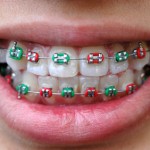
Enamel demineralisation or white spot lesions are frequent adverse outcomes from fixed appliance orthodontic treatment. They result from poor oral health maintenance during appliance wear and a number of studies of preventive interventions have been conducted. These primary studies have been summarised in a number of narrative and systematic reviews.
The aim of this overview of systematic reviews was to evaluate the evidence for the prevention of enamel demineralization during multi-bracketed fixed orthodontic treatment.
Methods
Searches were conducted in the Medline/PubMed, Cochrane Database of systematic reviews, Embase, Scopus, Web of Science Joanna Briggs Institute EBP (evidence-based practice) database with no limitations on language or date. Goggle Scholar and references lists were also searched with additional searches for grey literature on Open Grey and Google. Studies identifying as systematic reviews were considered. Two reviewers independently selected studies, extracted data and assessed risk of bias using both the Risk of Bias in Systematic Reviews (ROBIS) tool and Assessing the Methodological Quality of Systematic Reviews-2 (AMSTAR-2) tool. The degree of overlap of primary studies included in different systematic reviews was evaluated by generating the citation matrix and calculating the ‘corrected covered area’ with 0% to 5% a slight overlap, 6% to 10% a moderate overlap, 11% to 15% a high overlap, and above 15% a very high overlap.
Results
- 29 reviews published in 30 papers were included.
- 128 primary publications were included in the reviews with the degree of overlap between studies assessed as 2.8% (slight overlap).
- 3 of the reviews were from Cochrane, an initial review and two subsequent updates.
- 10 of the reviews had protocols registered with PROSPERO.
- 8 reviews conducted a risk of bias assessment and meta-analyses.
- 12 reviews only undertook a qualitative assessment.
- 9 reviews used the Grading of Recommendations Assessment, Development and Evaluation (GRADE) approach to assess the certainty of evidence.
- 5 reviews were considered to be at low risk of bias using ROBIS, 23 at high risk and 1 at unclear risk.
- 2 reviews were considered to have high overall confidence using AMSTAR-2, 4 moderate confidence, 4 low confidence and the remainder (19) critically low confidence.
- 18 reviews considered fluorides in any form, 5 reviews involved calcium phosphopeptide-amorphous calcium phosphate (CPP-ACP), 3 considered sealants, 2 reported on reminders, one of lasers and one of chlorhexidine.
- The GRADE certainty of evidence to support the findings in the reviews ranged from very low to moderate.
Conclusions
The authors concluded: –
Most of the systematic reviews on the prevention of enamel demineralization during multi-bracketed fixed orthodontic treatment have focused on the role of fluorides and, to a lesser extent, the role of sealants, CPP-ACP, re- minder therapy, and lasers. The majority of these reviews have a high risk of bias that jeopardizes the internal validity of their conclusions. Professional fluorides, sealants, reminder therapy, and lasers might be useful interventions to prevent enamel demineralization during multi- bracketed fixed orthodontic treatment; however, further studies are required to elucidate the role of CPP-ACP, chlorhexidine varnish, and powered toothbrushes. The clinicians should establish their clinical decisions on well- conducted systematic reviews, whereas future researchers should conduct systematic reviews with utmost circumspection to avoid the risk of bias in their reviews.
Comments
The authors pre-registered their review on PROSPERO and have conducted and extensive database search. 29 reviews were identified, one of these was a Cochrane review which included its initial version published in 2004 and two subsequent updates the latest being published in 2019 (Dental Elf – 27th Nov 2019) There is a question about whether all 3 versions should be included as only the most recent should be used. However, the authors highlight that all 3 are readily available and the inclusion criteria for the reviews have changed. Of the 29 included reviews the 2019 Cochrane review was the only one that was considered to be at low risk in all the domains of the ROBIS tool and addressing all the AMSTAR-2 questions and so having high overall confidence in its findings. The author note that the use of the AMSTAR-2 tool was a late variation to their initial published protocol. Only 128 primary studies were included in the 29 reviews and some of the included studies were of a split-mouth which are likely to suffer from cross-over effects and require more complex analysis. These designs were excluded from the 2019 Cochrane review.
This overview presents a very useful summary of the currently available systematic reviews. The authors call for and improvement in the conduct of systematic reviews which I agree is needed in dentistry. However, there is a more pressing need to improve the quality of primary research.Fixed banded orthodontic treatment is a common procedure and enamel demineralisation is a common adverse effect. Therefore rather than additional systemic reviews we more well conducted and reported primary studies of appropriate size reported in line with SPIRIT and CONSORT guidelines to provide high quality evidence to understand the best approach to addressing this question
Links
Primary Paper
Sardana D, Manchanda S, Ekambaram M, Yang Y, McGrath CP, Yiu CKY. Prevention of demineralization during multi-bracketed fixed orthodontic treatment: An overview of systematic reviews. Int J Paediatr Dent. 2021 Sep 25. doi: 10.1111/ipd.12927. Epub ahead of print. PMID: 34562331.
Other references
Dental Elf – 27th Nov 2019
Dental Elf – White Spot lesions blogs
